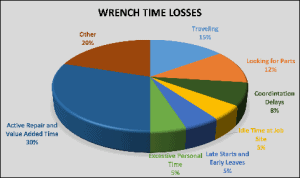 Implementing Parts Kitting is challenging as doing so requires numerous systems, processes, and people to work together. This paper describes appropriate steps for successful implementation of Parts Kitting in a sustainable manner and outlines pitfalls to avoid.
Implementing Parts Kitting is challenging as doing so requires numerous systems, processes, and people to work together. This paper describes appropriate steps for successful implementation of Parts Kitting in a sustainable manner and outlines pitfalls to avoid.
At an average facility, maintenance staff wrench time is approximately 30% (Figure 1). That means that they only spent this amount of their time performing repairs and Preventative Maintenance or other value added work. The rest of the time is lost for a variety of reasons. Businesses work to address this lack in efficiency by implementing a maintenance planning & scheduling functions. When properly implemented, many realize the benefits in craft efficiency. However, improper implementation of these planning and scheduling functions leads to minimal or no improvement in work productivity. One of the main reasons for this lack of improvement is the time the craft spend traveling & looking for parts.
In a typical Planning & Scheduling process, planning identifies the parts, and scheduling ensures the parts are on site and available before being released for execution. With this protocol, the craft still has to dedicate a significant portion of their time to obtaining parts. This is where Parts Kitting can become an invaluable step in the Planning & Scheduling process. On average the maintenance staff spends approximately 15% of their time traveling and 12% looking for parts. Now not all of this traveling is related to the storeroom, but a good portion of it is. By implementing a Parts Kitting process, we can dramatically reduce the time spent traveling and looking for parts.
Eruditio, LLC Links:
- Eruditio, LLC
- A Smarter Way of Preventative Maintenance – Free eBook
- Maintenance Planning & Scheduling: Planning for Profitability Video Course
The post 42 Unlocking Wrench Time with Parts Kitting appeared first on Accendo Reliability.
